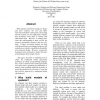Free Online Productivity Tools
i2Speak
i2Symbol
i2OCR
iTex2Img
iWeb2Print
iWeb2Shot
i2Type
iPdf2Split
iPdf2Merge
i2Bopomofo
i2Arabic
i2Style
i2Image
i2PDF
iLatex2Rtf
Sci2ools
COMPSAC
2002
IEEE
2002
IEEE
A Graphically Based Language for Constructing, Executing and Analysing Models of Software Systems
With computer systems becoming ever larger and more complex, the cost and effort associated with their construction is increasing and the systems are now sufficiently complex that developers need help to analyse and understand them. However, at design time, when this understanding is most crucial, the system is unavailable because it has yet to be built. Formal, executable models can help with this problem by providing developers with a platform on which to establish the feasibility of a proposed design. However, commercial developers seem reluctant to employ this type of modelling in their design activity. This paper describes a modelling tool in which the traditional model generation technique of writing “programming language like”code is replaced with a model generation tool which uses a graphical representation of models whilst retaining sufficient formality to permit the models to be executed, or converted into code for analysis by a traditional model checking tool. 1 Why bui...
| Added | 14 Jul 2010 |
| Updated | 14 Jul 2010 |
| Type | Conference |
| Year | 2002 |
| Where | COMPSAC |
| Authors | Robert John Walters |
Comments (0)

